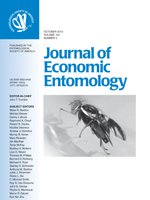The development of integrated pest management is hampered by lack of information on how insect pest abundances relate to yield losses, and how pests are affected by control measures. In this study, we develop integrated pest management tactics for Apion spp. weevils (Coleoptera: Brentidae) in seed production of red clover, Trifolium pratense L. We tested a method to forecast pest damage, quantified the relationship between pest abundance and yield, and evaluated chemical and biological pest control in 29 Swedish red clover fields in 2008 and 2011. Pest inflorescence abundance, which had a highly negative effect on yield, could be predicted with pan trap catches of adult pests. In 2008, chemical control with typically one application of pyrethroids was ineffective both in decreasing pest abundances and in increasing yields. In 2011, when chemical control included applications of the neonicotinoid thiacloprid, pest abundances decreased and yields increased considerably in treated field zones. A post hoc analysis indicated that using pyrethroids in addition to thiacloprid was largely redundant. Infestation rates by parasitoids was higher and reached average levels of around 40% in insecticide treated field zones in 2011, which is a level of interest for biological pest control. Based on the data presented, an economic threshold for chemical control is developed, and guidelines are provided on minimum effective chemical pest control.
BioOne.org will be down briefly for maintenance on 17 December 2024 between 18:00-22:00 Pacific Time US. We apologize for any inconvenience.
How to translate text using browser tools
1 October 2012
Towards Integrated Pest Management in Red Clover Seed Production
Ola Lundin,
Maj Rundlöf,
Henrik G. Smith,
Riccardo Bommarco
ACCESS THE FULL ARTICLE
It is not available for individual sale.
This article is only available to subscribers.
It is not available for individual sale.
It is not available for individual sale.

Journal of Economic Entomology
Vol. 105 • No. 5
October 2012
Vol. 105 • No. 5
October 2012
Apion spp.
biological control
Spintherus dubius
Thiacloprid
Trifolium pratense




